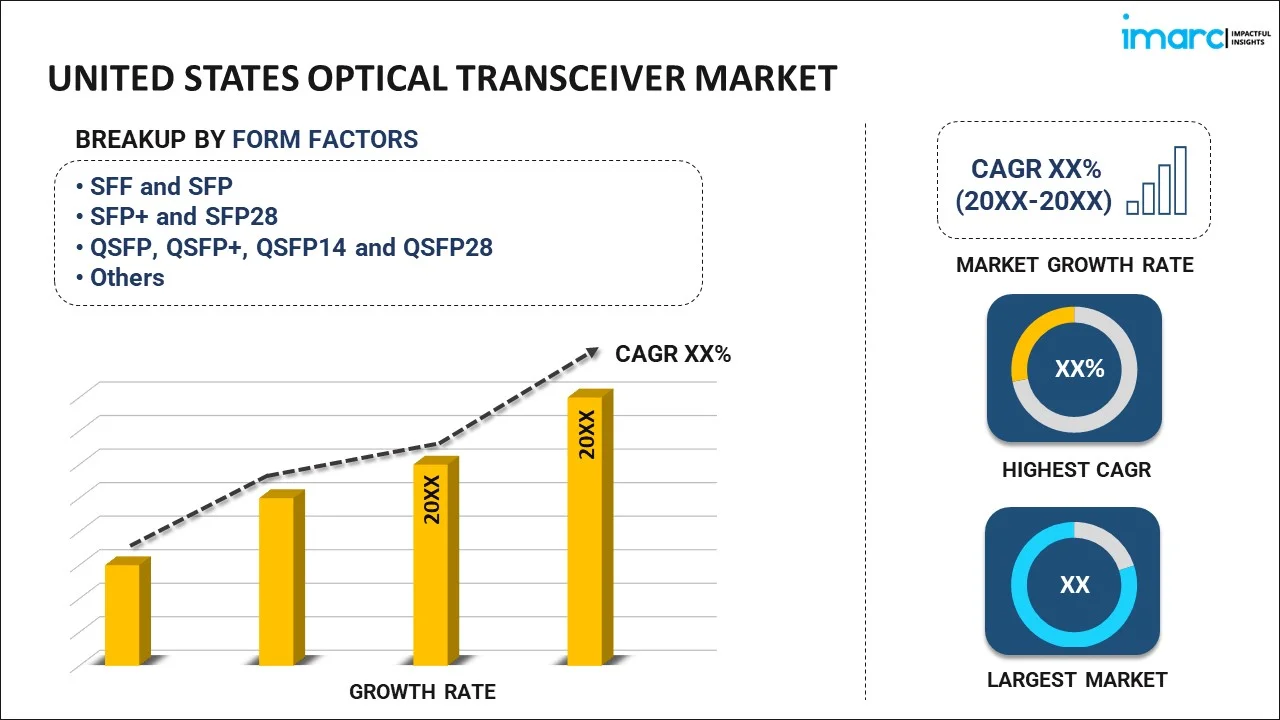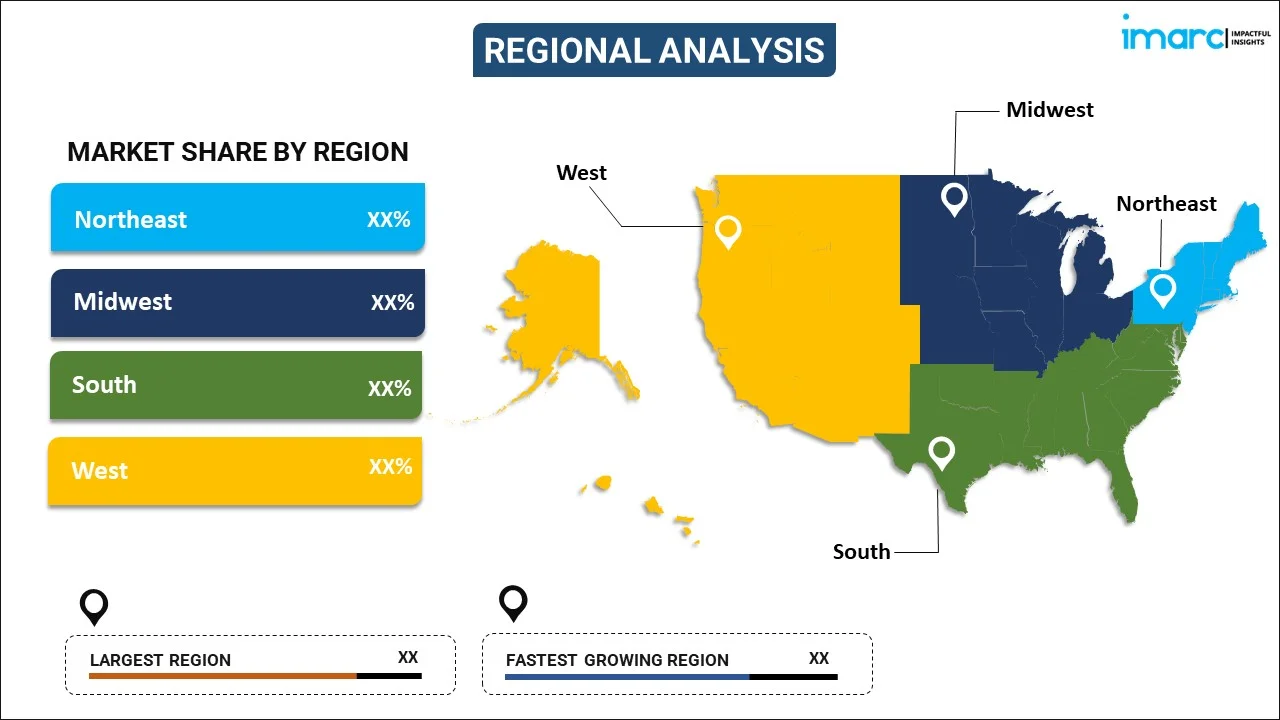
United States Optical Transceiver Market Report by Form Factor (SFF and SFP, SFP+ and SFP28, QSFP, QSFP+, QSFP14 and QSFP28, CFP, CFP2, and CFP4, XFP, CXP, and Others), Fiber Type (Single Mode Fiber, Multimode Fiber), Data Rate (Less Than 10 Gbps, 10 Gbps To 40 Gbps, 40 Gbps To 100 Gbps, More Than 100 Gbps), Connector Type (LC Connector, SC Connector, MPO Connector, RJ-45), Application (Data Center, Telecommunication, Enterprises), and Region 2025-2033
Market Overview:
The United States optical transceiver market size reached USD 3.3 Billion in 2024. Looking forward, IMARC Group expects the market to reach USD 10.0 Billion by 2033, exhibiting a growth rate (CAGR) of 13.08% during 2025-2033. The continuous expansion of data centers, the increasing deployment of 5G networks, the growing internet traffic, the rapid advancements in fiber optic technology, development of higher-capacity fibers and improved modulation techniques, and the rise of edge computing are some of the factors propelling the market.
|
Report Attribute
|
Key Statistics
|
|---|---|
|
Base Year
|
2024 |
|
Forecast Years
|
2025-2033
|
|
Historical Years
|
2019-2024
|
| Market Size in 2024 | USD 3.3 Billion |
| Market Forecast in 2033 | USD 10.0 Billion |
| Market Growth Rate (2025-2033) | 13.08% |
An optical transceiver, often referred to as an "optic" or "optical module," is a crucial component in optical communication systems, facilitating the transmission and reception of data using light signals. It serves as the interface between electrical signals in devices like routers, switches, and servers and the optical fibers that carry data over long distances. The optical transceiver's primary function is to convert electrical signals into optical signals for transmission and vice versa for reception. In its transmitting mode, the optical transceiver takes electrical signals and transforms them into optical signals using a light source, typically a laser diode. These optical signals are then transmitted over optical fibers, where they travel as pulses of light. In the receiving mode, the optical transceiver receives incoming optical signals from the fiber and converts them back into electrical signals using a photodiode or similar optical detector. Optical transceivers come in various form factors and configurations, including small form-factor pluggables (SFP), quad small form-factor pluggables (QSFP), and others, each designed for specific applications and data rates. As a fundamental component in optical communication networks, optical transceivers play a crucial role in enabling high-speed, reliable, and efficient data transmission over both short and long distances.
United States Optical Transceiver Market Trends:
The market in the United States is majorly driven by the increasing demand for high-performance optical communication solutions. In line with this, the expansion of data centers is significantly contributing to the market growth. With the escalating need for data storage, processing, and cloud services, data centers are continuously scaling up their infrastructure. Optical transceivers, integral to these environments, support the high-speed and efficient transmission of vast amounts of data between servers and across data center networks. Furthermore, the rising deployment of 5G networks is positively influencing the market. As 5G technology gains widespread adoption, there is a heightened demand for optical transceivers to handle the enhanced data rates, low latency, and increased bandwidth requirements associated with 5G connectivity. Moreover, the growth of internet traffic, fueled by the growth of online activities, streaming services, and the Internet of Things (IoT), propels the market expansion. As consumers and businesses demand faster and more reliable internet connectivity, optical transceivers play a key role in meeting these requirements by enabling high-speed data transmission over optical fibers. Advancements in fiber optic technology are driving market growth by enhancing the capabilities of optical transceivers. The development of higher-capacity fibers, improved modulation techniques, and innovations in materials contribute to the overall performance and efficiency of optical transceivers, allowing for faster and more reliable data transmission. Besides, the escalating adoption of edge computing is bolstering the market. Edge computing, which involves processing data closer to the source of data generation, relies on efficient and high-speed connectivity. As businesses across industries prioritize high-speed, reliable, and efficient data communication, the market is poised for sustained growth.
United States Optical Transceiver Market Segmentation:
IMARC Group provides an analysis of the key trends in each segment of the market, along with forecasts at the country level for 2025-2033. Our report has categorized the market based on form factor, fiber type, data rate, connector type, and application.
Form Factor Insights:

- SFF and SFP
- SFP+ and SFP28
- QSFP, QSFP+, QSFP14 and QSFP28
- CFP, CFP2, and CFP4
- XFP
- CXP
- Others
The report has provided a detailed breakup and analysis of the market based on the form factor. This includes SFF and SFP, SFP+ and SFP28, QSFP, QSFP+, QSFP14 and QSFP28, CFP, CFP2, and CFP4, XFP, CXP, and others.
Fiber Type Insights:
- Single Mode Fiber
- Multimode Fiber
A detailed breakup and analysis of the market based on the fiber type have also been provided in the report. This includes single mode fiber and multimode fiber.
Data Rate Insights:
- Less Than 10 Gbps
- 10 Gbps To 40 Gbps
- 40 Gbps To 100 Gbps
- More Than 100 Gbps
The report has provided a detailed breakup and analysis of the market based on the data rate. This includes less than 10 Gbps, 10 Gbps to 40 Gbps, 40 Gbps to 100 Gbps, and more than 100 Gbps.
Connector Type Insights:
- LC Connector
- SC Connector
- MPO Connector
- RJ-45
A detailed breakup and analysis of the market based on the connector type have also been provided in the report. This includes LC connector, SC connector, MPO connector, and RJ-45.
Application Insights:
- Data Center
- Telecommunication
- Enterprises
The report has provided a detailed breakup and analysis of the market based on the application. This includes data center, telecommunication, and enterprises.
Regional Insights:

- Northeast
- Midwest
- South
- West
The report has also provided a comprehensive analysis of all the major regional markets, which include Northeast, Midwest, South, and West.
Competitive Landscape:
The market research report has also provided a comprehensive analysis of the competitive landscape. Competitive analysis such as market structure, key player positioning, top winning strategies, competitive dashboard, and company evaluation quadrant has been covered in the report. Also, detailed profiles of all major companies have been provided. Some of the key players include:
- Arista Networks Inc.
- Broadcom Inc.
- Cisco Systems Inc.
- Coherent Corp.
- Juniper Networks Inc.
- Smiths Interconnect Inc. (Smiths Group plc)
- Source Photonics Inc.
(Please note that this is only a partial list of the key players, and the complete list is provided in the report.)
United States Optical Transceiver Market Report Coverage:
| Report Features | Details |
|---|---|
| Base Year of the Analysis | 2024 |
| Historical Period | 2019-2024 |
| Forecast Period | 2025-2033 |
| Units | Billion USD |
| Scope of the Report | Exploration of Historical Trends and Market Outlook, Industry Catalysts and Challenges, Segment-Wise Historical and Future Market Assessment:
|
| Form Factors Covered | SFF and SFP, SFP+ and SFP28, QSFP, QSFP+, QSFP14 and QSFP28, CFP, CFP2, and CFP4, XFP, CXP, Others |
| Fiber Types Covered | Single Mode Fiber, Multimode Fiber |
| Data Rates Covered | Less Than 10 Gbps, 10 Gbps To 40 Gbps, 40 Gbps To 100 Gbps, More Than 100 Gbps |
| Applications Covered | Data Center, Telecommunication, Enterprises |
| Regions Covered | Northeast, Midwest, South, West |
| Companies Covered | Arista Networks Inc., Broadcom Inc., Cisco Systems Inc., Coherent Corp., Juniper Networks Inc., Smiths Interconnect Inc. (Smiths Group plc), Source Photonics Inc. etc. (Please note that this is only a partial list of the key players, and the complete list is provided in the report.) |
| Customization Scope | 10% Free Customization |
| Post-Sale Analyst Support | 10-12 Weeks |
| Delivery Format | PDF and Excel through Email (We can also provide the editable version of the report in PPT/Word format on special request) |
Key Questions Answered in This Report:
- How has the United States optical transceiver market performed so far and how will it perform in the coming years?
- What has been the impact of COVID-19 on the United States optical transceiver market?
- What is the breakup of the United States optical transceiver market on the basis of form factor?
- What is the breakup of the United States optical transceiver market on the basis of fiber type?
- What is the breakup of the United States optical transceiver market on the basis of data rate?
- What is the breakup of the United States optical transceiver market on the basis of connector type?
- What is the breakup of the United States optical transceiver market on the basis of application?
- What are the various stages in the value chain of the United States optical transceiver market?
- What are the key driving factors and challenges in the United States optical transceiver?
- What is the structure of the United States optical transceiver market and who are the key players?
- What is the degree of competition in the United States optical transceiver market?
Key Benefits for Stakeholders:
- IMARC’s industry report offers a comprehensive quantitative analysis of various market segments, historical and current market trends, market forecasts, and dynamics of the United States optical transceiver market from 2019-2033.
- The research report provides the latest information on the market drivers, challenges, and opportunities in the United States optical transceiver market.
- Porter's five forces analysis assist stakeholders in assessing the impact of new entrants, competitive rivalry, supplier power, buyer power, and the threat of substitution. It helps stakeholders to analyze the level of competition within the United States optical transceiver industry and its attractiveness.
- Competitive landscape allows stakeholders to understand their competitive environment and provides an insight into the current positions of key players in the market.
Need more help?
- Speak to our experienced analysts for insights on the current market scenarios.
- Include additional segments and countries to customize the report as per your requirement.
- Gain an unparalleled competitive advantage in your domain by understanding how to utilize the report and positively impacting your operations and revenue.
- For further assistance, please connect with our analysts.
 Inquire Before Buying
Inquire Before Buying
 Speak to an Analyst
Speak to an Analyst
 Request Brochure
Request Brochure
 Request Customization
Request Customization




.webp)




.webp)












